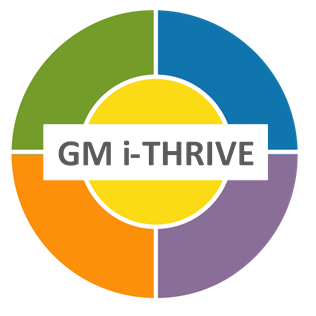
The GM i-THRIVE Programme Team spoke with Dr Rosie Noyce, Clinical Psychologist and Dr Carla Innes, Clinical Psychologist at Stockport’s Healthy Young Minds (HYM’s), Pennine Care NHS Foundation Trust about the development of the Consultation Care Pathway in Stockport.
Download this implementation story.
Stockport’s Learning Difficulties (LD) Care Pathway
The transforming care agenda aims to improve the lives of children, young people with a learning disability and/or autism who display challenging behaviours, including those with a mental health condition.

Stockport’s mental health providers aim to better support children and young people (C&YP) with moderate or severe learning difficulties and/or challenging behaviours. Historically referrals of C&YP with severe LD were not accepted by Stockport Healthy Young Minds team (HYMs: Stockport’s CAMHS service), and the Children’s Community Learning Disability Team (CCLDT) service mostly accepted younger children and those with less severe challenging behaviours. This left a gap in service provision for 16-18 year olds living in Stockport; due to the standard offer for these C&YP being antipsychotic medication prescribed by a paediatrician.
There was a need to address challenging behaviours early and influence a more positive outcome for all children, young people and families with LD, not just those currently accessing specialist services. It was thus deemed important to increase the support offer to C&YP and their families with LD.
Stockport’s LD team
The new LD team is part of the existing HYMs and offers a specialist mental health service to the identified population. The team consists of 1×0.6 FTE clinical psychologist as clinical lead, 1xFTE clinical psychologist, 1×0.5 FTE psychiatrist and 1xFTE mental health practitioner. This team was commissioned by Pennine Care NHS Foundation Trust to work jointly with the CCLD team, who are commissioned by Stockport NHS Foundation Trust, to form the LD care pathway.
The LD care pathway was set up with the key value of enhancing quality of life for children and young people. Parents, carers, and where possible young people were involved in shaping the service, helping identify gaps and areas of improvement. Key priorities identified were C&YP needing to access the right support at the right time as well as a service that is responsive and accessible. Thus a model focussing on supervision, consultation and service development was created.
Image 1: LD care pathway website
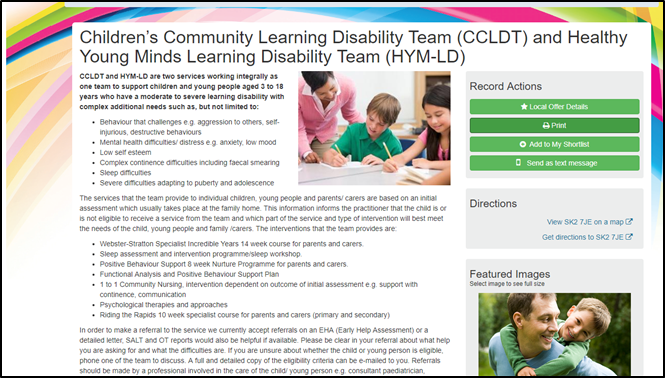
Stockport’s LD team offer
Specialist school consultation:
The LD team offers school consultations to Stockport’s four specialist schools. Each specialist school is offered a regular service consisting of: staff and parent consultation, staff Positive Behaviour Support (PBS) training workshops, and reflective practice for staff. Schools are given the opportunity to shape their school’s consultation offer each academic year to enable them to meet their specific needs. Schools are offered half a day per half term for consultations. Consultations are attended by one HYMs team member and one CCLD team member.
Sixty-five consultations/individual discussions took place in the 2017/18 academic year, typically varying between 30-60 minutes in length. This figure does not take into account consultation slots offered but not attended and brief informal discussions about children and young people that occurred as a result of the increased presence of the team within the schools, and the greater level of partnership working that naturally evolved as a result of co-location. Staff training, parent and staff workshops and staff reflection groups are held in addition to the individual consultation sessions.
What were some of the challenges you faced?
A key challenge the team has faced is being able to deliver a care pathway with two teams from different NHS trusts (Pennine Care and Stockport NHS Foundation trust). The teams have different governance and databases making effective communication and collaboratively working more challenging.
Despite a new team being commissioned there is still limited support available for C&YP in Stockport as the team does not have the capacity to offer a regular service to mainstream schools. The team was not commissioned to offer and deliver a consultation and supervision model to schools. However, because this way of working was seen as a priority by the team, they reconfigured resources in order to build in a school consultation model, which now needs sustaining through appropriate contractual arrangements.
How does the Stockport LD Care Pathway fit in with your local plans to implement the THRIVE Framework?
Stockport was one of the early accelerator sites for implementing the THRIVE Framework for system change (Wolpert et al., 2019). The development of the care pathway was an opportunity to use the THRIVE Framework to think differently about C&YP services as a whole. The care pathway is a great example of a whole system working to address the different THRIVE Framework needs based groupings for a specific population.
Below are some examples:
Image 1: services of offer
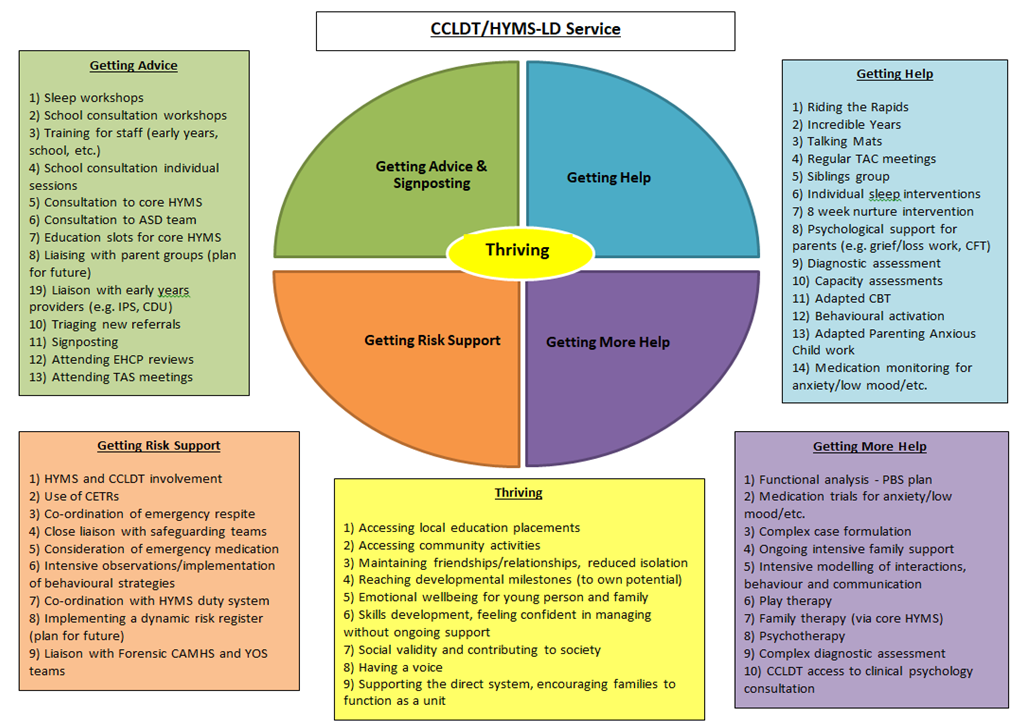
How has the care pathway changed things for staff and service users?
Referral rates:
Table 1: showing referral rates into HYM’s and CCLDT (2015-2018):
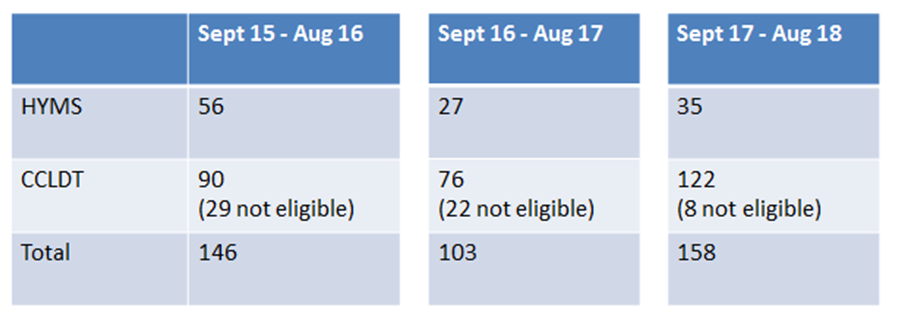
Since the introduction of school consultations (2016/2017 academic school year); referral rates into both HYMs and CCLDT initially reduced. However there has been a surge in referrals over the last academic year, which mirrors the 25-30% increase in referrals rates into the generic HYMs team. There are several potential reasons for this. Unfortunately voluntary sector services which previously supported, children and young people in Stockport are reducing in number or are increasing their access thresholds, resulting in less available support to children and young people and their families outside of established NHS services. The majority of the increase in referrals to CCLDT is for pre-school aged children (see Fig1), suggesting that there is an increased awareness of early detection and providing early interventions for this cohort of young people. The increase in referrals for younger children (3-4 year olds) suggests our aim to intervene at an earlier age is working (see Fig1).
Of note, there appears to have been a reduction in the number of ineligible referrals which is likely to be a direct result of referrals being screened through the school consultation process, and increased liaison and capacity building with schools and other professionals (see Table 1).
Fig 2: Referrals to CCLDT by age band.
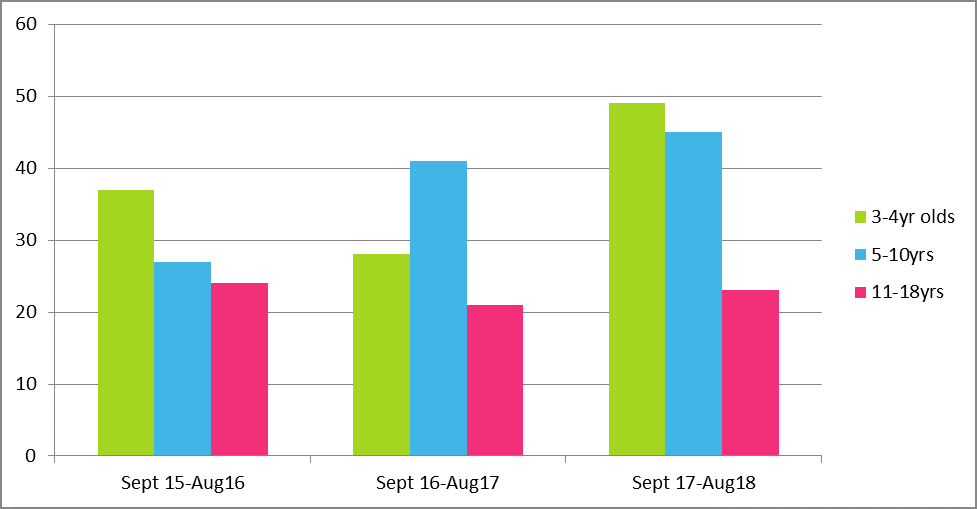
Qualitative feedback:
Consultees were invited to provide more detailed feedback relating to their consultation experience in 2017/18. Comments demonstrated high levels of satisfaction with consultation as well as reports of gaining new and increased knowledge and skills through consultations.
“It was good to have time to reflect on challenging behaviour and its impact on staff emotionally as it is such a big part of the job and staff are often forgotten in the midst of situations”
“After attending the groups, I feel I have acquired a lot of understanding on how to understand and handle certain behaviours. I have also learned a lot of new skills on my thinking and understanding a child’s behaviour”
Representatives from each of the schools were also asked to provide feedback at the end of each school year regarding the consultation model. This indicated that consultation is a valued addition to the school environment.
“The consultations this year have offered a positive contribution to our work in school supporting young people and their families with complex needs. Feedback from the parents who have accessed the consultations has been extremely positive and in some cases it has ‘paved the way’ for follow up discussions between families and staff”
“The benefits of the sessions, in conjunction with the Team Around a School meetings, continue to provide a reduction of Team Around a Child meetings for our pupils and families, as well as helping to maintain positive relationships with families, and an outlet for parents/carers to access support for themselves, along with signposting and determining if a referral and further support is required via HYMS/CCLDT”
“The feedback we receive [from staff] consistently shows that the input we receive from HYMs/CCLDT is of enormous benefit to the entire school community both in terms of the referral pathway and intervention as well as the workshop-based training. Feedback from staff has been extremely positive and our relationship with HYMs/CCLDT staff is a key element of our behaviour intervention protocol”
What is the future of the Stockport Care Pathway?
We have seen a huge impact from the school consultation care pathway on referrals and the ability of the team to intervene early. There is a clear need to extend and expand the school consultation service into early year’s nursery settings and mainstream schools with a ‘resource base’. This would allow the service to reach a greater number of children and young people with moderate to severe LD and provide early intervention and proactive strategies to impact challenging behaviours. The service has identified that the school consultation process would benefit from closer working with other disciplines such as Educational Psychology, Speech and Language Therapy and Occupational Therapy. Consultation has demonstrated a clear need to improve C&YP’s journey through services, and a multi-agency pathway with health, education and social care would have a greater impact. The team has been working with commissioners in order to strengthen and sustain the service in this way and be able to better support children, young people and their families in Stockport.
If you would like to find out more information, please contact Carla Innes: carlainnes@nhs.net.


Edited by the GM i-THRIVE Programme Team, and the National i-THRIVE Programme Team.
Written November 2019.